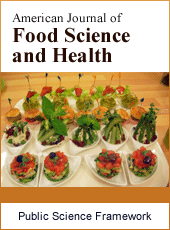American Journal of Food Science and Health
Articles Information
American Journal of Food Science and Health, Vol.1, No.2, Jun. 2015, Pub. Date: May 18, 2015
Physicochemical and Functional Properties of Four New Genotypes (Cyamopsis Tetragonoloba L.) of Guar Gum
Pages: 43-50 Views: 5864 Downloads: 1627
[01]
Amir A. Eldirany, Department of Nutrition and Food Technology, Faculty of Science and Technology, Omdurman Islamic University, Omdurman, Sudan.
[02]
Azhari A. Mohamed Nour, Department of Nutrition and Food Technology, Faculty of Science and Technology, Omdurman Islamic University, Omdurman, Sudan.
[03]
Khadir E. Khadir, Department of food science &Technology, Faculty of Agriculture, Omdurman Islamic University, Omdurman, Sudan.
[04]
Khalid A. Gadeen, Department of Nutrition and Food Technology, Faculty of Science and Technology, Omdurman Islamic University, Omdurman, Sudan.
[05]
Mohamed AE. M. Ibrahim, Faculty of Public and Environmental Health, University of Khartoum, Sudan, Now, Albaha University, FAMS, Albaha City, Saudi Arabia.
The objective of this work was to study the physicochemical and functional properties of guar gum extracted from four new genotypes of guar seeds (GM5, GM6, GM9 and GM34) collected from the experimental farm of University of Khartoum- Shambat .The physical characteristics and chemical composition were investigated for the gum extracted from the guar seeds, water holding capacity, emulsifying stability and foaming properties were also determined for the gum. Results obtained showed that the chemical composition of guar gum confirm insignificant (P≥0.05) variation in protein and carbohydrate content among all genotypes. Minerals content (macro elements) of guar gum were 0.0075-0.020%, 0.019-0.024%, 0.20 - 0.30%, 0.020 – 0.035% and 0.060 – 0.09% for P, Na, K, Ca and Mg, respectively .While (micro elements) (mg/kg) were 17.74-43.5, 3.7- 27.4 and 0.19-0.54% for Fe, Zn, Pb, respectively. The results of functional properties of guar gum tested revealed that GM34 had significantly (P≤0.05) lowest value of pH and optical density, and GM6 genotype had significantly (P≤0.05) the lowest value of viscosity (0.11 cps). Genotype GM5 and GM6 gives significant (P≤0.05) highest values of solubility compare with the values given by genotype GM34 and GM9. Investigation revealed that Water Holding Capacity (WHC) followed GM34 88.97%, GM5 81.67%, GM9 79.02% and GM6 58.84%. Also results revealed insignificant (P≥0.05) variation in foaming properties values for all genotypes under study. Generally the genotype GM34 had the best functional properties of guar gum. The genetic variations have affected the chemical composition, physical and functional properties of guar gum. The Foaming Capacity (FC) is not high, but the values of foam stability (FS) were highest of guar gum.
Guar Gum, Genotypes, Optical Density, Water Holding Capacity, Emulsifying Stability, Foaming Properties and Elements
[01]
Ahrens, F.,Pfeuffer, M., Hagemeister, H. and Barth, C.A. (1991). “The hyochdesterolemic effect of guar gum depends on dietary sucrose studies in minipigs”. Zeitschriftfur-Ernahrungswissenschaft.30 (2):109-117.
[02]
AOAC, (1995). Association of Official Analytical Chemists. Official Method of Analysis, 〖16〗^th edn. Washington D.C
[03]
AOAC. (1984). “Official Methods of Analysis”. 14th edition.Published by AOAC Inc. Virginia 22209. USA.
[04]
Boggs, A.D. (1949). Viscosity relation of amylase and amylopectin guaran. M.Sc.Thesis,Purdue University. West Lafayette. Indiana.
[05]
Chopra, R.N., Nayer, S. L and Chopra, I.C. (1956). Glossary of Indian Medical Plants. Ranchi: Catholic Press.
[06]
Chudzikowski, R.J. (1971). Guar gum and its application. J. Soc. Cosmet. Chem. 22:43-60.
[07]
Dickinson, E. (2003) .Hydrocolloids at interface and influence on the properties of dispersed system. J.Food hydrocolloids, 17:25-39.
[08]
Eatherton, L, E., Platz, P.E and Cosgrove, F.P. (1955). Guar Gum as binder and disintegrator for certain compressed tablets. Drug Stand. 23:42-47.
[09]
Eldaw, G.E. (1998). A study of guar seed and guar gum properties (Cyamopsis tetragonoloba (L). M.Sc Thesis, Faculty of Agriculture, U of K, Sudan.
[10]
Flowerman, P.M. (1987). The Potential of guar in Sudan agriculture, process, industry and trade. Unpublished report on a mission to Sudan, 19th March-30th June.
[11]
Hansen, J. R. (1978). Functional properties of Gum Arabic. J.Agric. Food, Chem, 26:301-304.
[12]
Kabirullah, M. and Wills, R.B. (1982). Functional properties of acetylated and succinylated sun flower protein,J. Food technology.17:235-249.
[13]
Kinsella, J. E (1979). Functional properties of Soy Proteins. J.Amer. Oil chem. Soc., 56: 242-246.
[14]
Londin, K., Holm, G., Tengborn, L. and Smith, U. (1992). Guar gum improves insulin sensitivity, blood lipids, blood pressure and fibrinolysis is healthy men. American Journal of Clinical Nutrition. 56 (6): 1061-1065).
[15]
Mantella, C. L. (1965).The water soluble gum. Harfner, inc .New York, USA.
[16]
Pearson, D. (1981). Chemical Analysis of Food. Edn. Published by Egon, H; Kirk, R.S and Sawyer, New York.
[17]
Peterson, R. G. (1985). Design and analysis of experiments. March Dekker Inc., New York, PP: 429.
[18]
Sabah Elkhier, M. K. (1999). Improvement of yield and quality of Guar (Cyamopsis tetragonoloba). PhD. Thesis, Faculty of Agriculture, U of K,Sudan.
[19]
Sharma, B. R; Chechani, V., Dhuldhoya, N.C. and Merchant, U. C. (2007). “Guar Gum” J. Science Tech Entrepreneur. Lucid Colloids Limited, Jodhpur-342005, Rajasthan, India.
[20]
Vuorinen, M. H, Sinisalo, M. and Koivisto, V. N. (1992). Guar gum insulin-dependent diabetes:effects on glycemic control and serum lipoprotein. American Journal of Clinical Nutretion. 25(6): 1056-1060.
[21]
Whistler, R. L (1954). Guar gum, Locust bean gum and others. Adc. Chem. Ser.11:45- 50.
[22]
Whistler, R. L and Hymowitz, T. (1979). Guar Agronomy, Production, Industrial Use, and Nutrition. Purdue University Press. West Lafayette, Indiana,USA.
[23]
Whistler, R. L and Smith, C.C. (1952). Acrystalline mannotriose from the enzymatic hydrolysis of guaran. J. Am. Chem. Soc. 74: 3795-3796.

ISSN Print: 2381-7216
ISSN Online: 2381-7224
Current Issue:
Vol. 7, Issue 4, December Submit a Manuscript Join Editorial Board Join Reviewer Team
ISSN Online: 2381-7224
Current Issue:
Vol. 7, Issue 4, December Submit a Manuscript Join Editorial Board Join Reviewer Team
| About This Journal |
| All Issues |
| Open Access |
| Indexing |
| Payment Information |
| Author Guidelines |
| Review Process |
| Publication Ethics |
| Editorial Board |
| Peer Reviewers |


